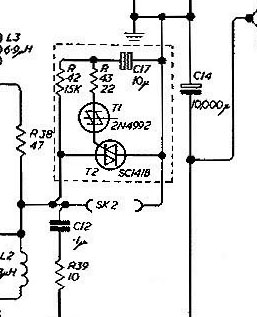
I never felt very happy with Quad's LS protection circuit.
In fact all it does is short-circuiting the outputs if there is a DC-component in the speaker-signal.
Word goes that in the 405 MK II the protection circuit has been improved. I'm sorry to say that's not a fact. The only thing that changed is that it was integrated on the circuit-boards. In the 405 MK I it was soldered to the LS-plugs.
2 Weeks ago I got an e-mail from Olivier, who bought a 405 on Ebay I revised and sold on Ebay a few months ago:
"Bonjour, je viens de faire l'acquisition d'un ampli Quad 405 modifié par vos soins à Chagoumy (pseudo ebay). L'essai chez lui s'était avéré positif. Je ramène l'ampli chez moi et clac: bruit énorme sur la voie droite..et pire. Le tweeter des 104/2 (voie droite) grille !! Je ne comprends pas. Je rééssaye sur un autre système. Idem."
One of the BDY77 endstage-transistors was grilled and the 405 has the bad attitude to put -50 Volt on the speaker-outputs when this happens. Unfortunately in Olivier's 405 someone had replaced the protection-circuit with 4A fuses. This will protect the speakers against overload but not against DC-voltage.
Olivier's 405 is up and running again but it was time to think about a better protection-circuit. A circuit that monitors the output and switches on the speakers after a few seconds when everything is OK and that switches them off immediately if there is a DC-component or when the power is cut.
I heard about the Velleman K4700 protection circuit (see www.velleman.be and surf to "projects"), so I built one and tried to put it in the 405.
But where?
There is not much space in a 405 so I had to screw it on the top-cover. Anybody who has a better idea will be rewarded with a box of Belgian Chocolates.
Anyway, it's ugly but it works fine ;-(
Stefaan


Hi,
ReplyDeleteWhat is the cost of such a circuit?
I've also heard that protection circuits generally risk distorting the signal. Is there a risk, or can you give evidence that there is no distorsion?
Best regards,
Jan
The cost is about 20 Euro in most electronics-shops.
ReplyDeleteThere is no distortion at all because the signal only goes through the relays that cut the output when there is a problem, not through the rest of the circuit.
It has its own power-supply so it does not influence the amp's power supply neither.
Stefaan
Hello,
ReplyDeleteI would second Stefaan's opinion and recommend this additional protection, as it would seem that the built-in circuit is not always effective.
Noticing a lot of distortion in the left-hand channel of my Quad 405 Mk I (purchased back in 1979), I opened the unit and replaced a blown 4A internal fuse, only to immediately blow up both left-channel fuses at power-on. After repair by TransTec Rotterdam (official Quad importer), my left-channel woofer appeared to be completely silent. No spare parts available anymore for those old Bowers & Wilkins DM6 (the "pregnant pinguin") and the dealer was only interested in selling a new pair. A bit of do-it-yourself attitude helped, as it turned out that only a capacitor on the loudspeaker cross-over circuit was faulty. I still wonder what came first, a breakdown in the cross-over or in the amplifier...
I think the output-transistor BDY77 broke first. In this case you get -50 Volt on the output if the protection-circuit is faulty.
ReplyDeleteThis would blow up the capacitor.
The other way around, if the capacitor died first, it would have killed the amplifier again, after it's repair ...
How much did you pay Transtec for the repair?
Stefaan
Hallo, Seb,
ReplyDeleteThat may be a solution, indeed.
Bu for "power-on ploc" you should foresee a time-delay on the LS swith-on of a few seconds.
Stefaan
I thought I would mention that the Velleman kit is superb and very easy to fit. Once you have replaced the smoothing caps with low profile ones, there is a lot of room and a bracket can be fixed to the rectifier heat sink. (chocolates). 10000uf is sufficient in this circuit unless you prefer an 'over based' circuit. The other thing to note Stefaan, is the two diodes can fit easily into the front panel spaced evenly from the original 'on' lamp and look like they were always there. Regards Barry. (reference point)
ReplyDelete